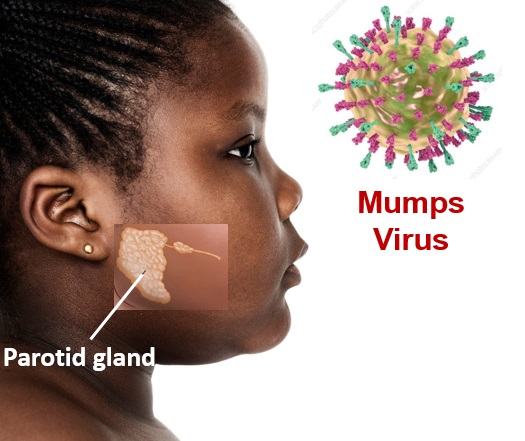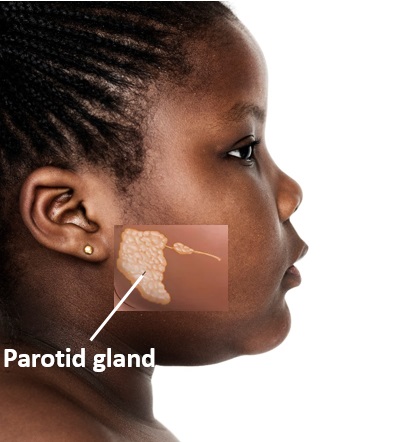Mumps Explained to Africans (With Prevention Tips)
Isma Butt, DPT, DLHA Volunteer and Freelance Medical Writer. Medically reviewed by A. Odutola, MB,BS, PhD

Close-up of the left-side of the face of an African girl with insert showing the location of the parotid gland, which is a common site for the mumps virus attack. In the foreground is also a 3D ilustration of the mumps virus. Photo credit. Freepik. Image design © DatelinehealthAfrica Inc. 2025.
Imagine waking up with a swollen jaw, fever, and feeling too tired to leave your bed. It may seem like a toothache to you. Or, have you seen children with their cheeks puffed up, like little hamsters? It may look cute, but it could signal a more serious condition known as mumps.
Many believe it is an old childhood disease, yet mumps still affects thousands of people worldwide each year.
It is a contagious virus (a special kind of germ) that spreads easily and attacks various parts of the body if not properly managed. Even though vaccines against mumps are available, outbreaks still occur especially in low income countries, highlighting the need to raise awareness about the disease and educate the public.
This article will explain all you need to know about mumps and highlight ways that you and your loved ones can stay free of the disease.
Mumps is an infectious disease caused by a specific germ called the mumps virus. It belongs to the family of viruses called paramyxoviruses. It is most notably associated with swelling of the salivary glands, specifically the parotid glands located near the ears (see fig. 1).

Fig. 1: Close-up view of the left face of an African girl with an insert showing the location of the parotid gland. Photo credit. Freepik. Image design © DatelinehealthAfrica Inc. 2025
Salivary glands produce a clear, watery fluid into your mouth, called saliva. This helps to keep your mouth from drying up, mix food for chewing and swallowing, as well as protect teeth from infection. When these glands become enlarged, it results in the characteristic "hamster face” appearance and a tender jaw (see fig. 2).

Fig. 2: Caricature of ahuman “hamster face” appearance in mumps side by side with a hamster for comparison. Image design: © DatelinehealthAfrica Inc. 2025
Children aged 2-9 are mostly affected, though adolescents and adults can get mumps too.
Mumps continues to be an issue in most African countries, especially where mumps vaccination is not included in the routine immunization schedule. The low rates of vaccination may cause outbreaks in the community. In certain areas, the availability of the vaccine is limited to private clinics, thus making it harder to protect the entire population.
Ghana witnessed a 140% increase in mumps cases from 2021 to 2022. Since the country does not include mumps in its childhood immunization program, frequent outbreaks occur every 4-5 years at a rate of 1000 cases per million.
Similarly, low vaccine coverage results in outbreaks in Zimbabwe. A 2024 study highlights the importance of universal MMR immunizations. Both countries show the dangers of uncontrolled mumps transmission. This situation can be managed by improving access to vaccines and creating awareness of mumps to prevent outbreaks.
The mumps virus is spread by close contact with an infected person. Close contact can be:
Fig. 3: Info-poster showing when you can catch mumps from an infected person © DatelinehealthAfrica Inc. 2025. Click on image to enlarge.
Since the mumps virus spreads easily, it can move through families, schools, and crowded places quickly. People with mumps can spread the virus approximately two days before their glands swell and for up to five days after Fig. 3). This means a person can be contagious before they feel sick. Therefore, the WHO recommends that mumps patients be isolated for 5 days after swelling of the glands.
Info poster of the symptoms of mumps. Credit: Adapted from here. Click on the image to enlarge.
Symptoms vary from mild to severe and generally appear about 2 to 3 weeks after you catch the virus, which is known as the incubation period. The average incubation period is about 17 days. Some people experience no symptoms at all, while others may feel very sick. Common signs include:
The majority of individuals recover within two weeks. Swelling and pain tend to reach their worst within 1 to 3 days and then gradually disappear. After swelling starts, you remain contagious for about five days. It is essential to avoid contact with others during this period to reduce the transmission of the virus.
What are the Complications of Mumps?
Mumps tends to be mild, particularly in children. However, it may lead to severe complications among teens and adults who are not vaccinated. The complications occur when the virus spreads to other tissues in the body. The following are some of the potential complications:
Doctors normally diagnose mumps through symptoms and physical examination. An important indicator is the swollen salivary glands. At times, doctors can order tests, including:
If you come in contact with someone with mumps, inform your doctor. Early diagnosis helps prevent the spread and allows for proper care.
There is no particular medication to cure mumps. The treatment aims to make you feel comfortable as your body fights against the virus. Steps you should take to aid recovery and lessen the symptoms include:
Most people recover fully with supportive care in 3 to 10 days. If complications occur, additional treatment is provided.
How to prevent mumps and protect your family. Credit: Adapted from here. Click on image to enlarge.
Getting yourself vaccinated is the best way to prevent mumps. The mumps vaccine is usually given as part of the MMR vaccine, which also protects against measles and rubella. Children are supposed to get two doses of the MMR vaccine:
Adults who are not vaccinated or are unsure should consult their doctor and discuss their options.
Call your doctor if you or your children have:
Conclusion
Mumps is a highly contagious disease that may result in pain, swelling, and even some severe health issues. Vaccination is the most effective form of protection for you and your family. The majority of individuals recover completely; however, it is important to know the symptoms, stay at home when unwell, and visit a doctor for serious symptoms. You can assist in preventing the transmission of the mumps in your community by keeping yourself updated and taking easy measures.
1. World Health Organization (WHO). Mumps Risk Communication and Community Engagement Guidance. [internet. n.d]. Cited July 16, 2025. Available from here
2. Gwinji PT, Murewanhema G, Moyo E, Dzinamarira T. Mumps outbreak in Zimbabwe: The case for universal MMR vaccination in Africa. Vaccine X. 2024 Nov 17;21:100586. doi: 10.1016/j.jvacx.2024.100586. Available from here
3. Marion Okoh-Owusu et al Against the clock: Effect of late detection of a mumps outbreak in the Western North Region of Ghana, 2022. Journal of Interventional Epidemiology and Public Health. 2025;8:13. doi: 10.37432/jieph-d-24-02036. Available from here
4. CDC. Mumps.[internet.]. 2025 July 11. Cited July 16, 2025. Available from here
5. Cleveland Clinic. Mumps prevention. [internet,n.d]. Cited July 16, 2025. Available from here
6. NHS.UK. Mumps. [internet,n.d]. Cited July 16, 2025. Available from here
7. Mediclinic. Mumps. [internet,n.d]. Cited July 16, 2025. Available from here
8. Mayoclinic. Mumps symptoms. [internet,n.d]. Cited July 16, 2025. Available from here
Published: July 21, 2025
© 2025. Datelinehealth Africa Inc. All rights reserved.
Permission is given to copy, use, and share content freely for non-commercial purposes without alteration or modification and subject to source attribution.
DATELINEHEALTH AFRICA INC., is a digital publisher for informational and educational purposes and does not offer personal medical care and advice. If you have a medical problem needing routine or emergency attention, call your doctor or local emergency services immediately, or visit the nearest emergency room or the nearest hospital. You should consult your professional healthcare provider before starting any nutrition, diet, exercise, fitness, medical or wellness program mentioned or referenced in the DatelinehealthAfrica website. Click here for more disclaimer notice.